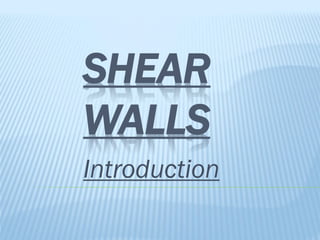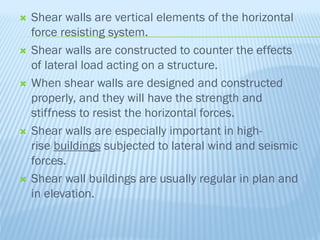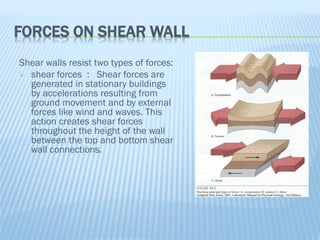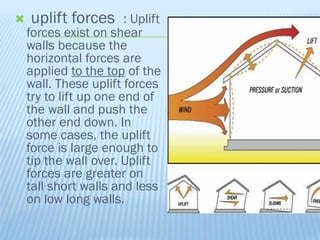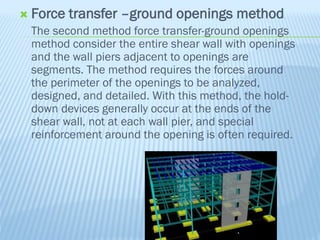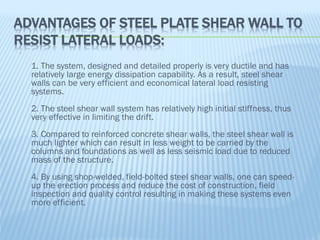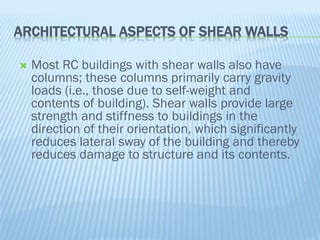Shear walls
- 2. Shear walls are vertical elements of the horizontal force resisting system. Shear walls are constructed to counter the effects of lateral load acting on a structure. When shear walls are designed and constructed properly, and they will have the strength and stiffness to resist the horizontal forces. Shear walls are especially important in high- rise buildings subjected to lateral wind and seismic forces. Shear wall buildings are usually regular in plan and in elevation.
- 3. Shear walls are not only designed to resist gravity / vertical loads, but they are also designed for lateral loads of earthquakes / wind. Shear wall structural systems are more stable. Walls have to resist the uplift forces caused by the pull of the wind. Walls have to resist the shear forces that try to push the walls over. Walls have to resist the lateral force of the wind that tries to push the walls in and pull them away from the building. Purpose of constructing shear walls
- 5. COMPARISIONS OF SHEAR WALL WITH CONSTRUCTION OF CONVENTIONAL LOAD BEARING WALLS Load bearing masonry is very brittle material. Due to different kinds of stresses such as shear, tension, torsion, etc., caused by the earthquakes, the conventional unreinforced brick masonry collapses instantly during the unpredictable and sudden earthquakes. The RCC framed structures are slender, when compared to shear wall concept of box like three-dimensional structures. Though it is possible to design the earthquake resistant RCC frame, it requires extraordinary skills at design, detailing and construction levels, which cannot be anticipated in all types of construction projects.
- 6. On the other hand even moderately designed shear wall structures not only more stable, but also comparatively quite ductile. In safety terms it means that, during very severe earthquakes they will not suddenly collapse causing death of people. They give enough indicative warnings such as widening structural cracks, yielding rods, etc., offering most precious moments for people to run out off structures, before they totally collapse.
- 7. FORCES ON SHEAR WALL Shear walls resist two types of forces: shear forces : Shear forces are generated in stationary buildings by accelerations resulting from ground movement and by external forces like wind and waves. This action creates shear forces throughout the height of the wall between the top and bottom shear wall connections.
- 8. uplift forces : Uplift forces exist on shear walls because the horizontal forces are applied to the top of the wall. These uplift forces try to lift up one end of the wall and push the other end down. In some cases, the uplift force is large enough to tip the wall over. Uplift forces are greater on tall short walls and less on low long walls.
- 10. CLASSIFICATION OF SHEAR WALLS Simple rectangular types and flanged walls (bar bell type) •Coupled shear walls
- 11. Rigid frame shear walls •Framed walls with in filled frames
- 12. Column supported shear walls •Core type shear walls
- 13. METHODS OF DESIGN OF SHEAR WALL Segmented shear wall method The segmented shear wall method uses full height shear wall segments that comply with ratio requirements and are usually restrained against overturning by hold down devices at the ends of each segment.
- 14. Force transfer –ground openings method The second method force transfer-ground openings method consider the entire shear wall with openings and the wall piers adjacent to openings are segments. The method requires the forces around the perimeter of the openings to be analyzed, designed, and detailed. With this method, the hold- down devices generally occur at the ends of the shear wall, not at each wall pier, and special reinforcement around the opening is often required.
- 15. Perforated shear wall method The third and newest method is the perforated shear wall method which is an empirical approach that does not require special detailing for force transfer adjacent to the openings. The perforated shear wall method, however, specifically requires hold-down devices at each end of the perforated shear wall.
- 16. Ludlow Castle School, undergoing retrofit. After structural retrofitting and earthquake preparedness training for faculty, staff, students and parents, Ludlow Castle School was officially designated a "model safe school" by the Indian government.
- 17. TYPES OF SHEAR WALLS RC SHEAR WALL It consists of reinforced concrete walls and reinforced concrete slabs. Wall thickness varies from 140 mm to 500 mm, depending on the number of stories, building age, and thermal insulation requirements. In general, these walls are continuous throughout the building height; however, some walls are discontinued at the street front or basement level to allow for commercial or parking spaces. PLYWOOD SHEAR WALL Plywood is the traditional material used in the construction of Shear Walls. The creation of pre-fabricated shear panels have made it possible to inject strong shear assemblies into small walls that fall at either side of a opening in a shear wall. As well as the use of a sheet steel, and steel-backed shear panel (i.e. Sure-Board) in the place of structural use plywood in shear walls, has proved to be far stronger in seismic resistance when used in shear wall assemblies. Plywood shear walls consist of: • Plywood, to transfer shear forces • Chords, to resist tension/compression generated by the over turning moments • Base connections to transfer shear to foundations.
- 18. MIDPLY SHEAR WALL The MIDPLY shear wall is an improved timber shear wall that was developed by redesigning the joints between sheathing and framing members, so that the failure modes observed in standard wall testing are virtually eliminated at lateral load levels high enough to cause failures in standard walls. In MIDPLY shear wall design, one ply of sheathing material is placed at the center of the wall between a series of pairs of studs oriented in a 90° rotated position relative to those in standard shear walls RC HOLLOW CONCRETE BLOCK MASONRY WALLS RHCBM walls are constructed by reinforcing the hollow concrete block masonry, by taking advantage of hollow spaces and shapes of the hollow blocks. It requires continuous steel rods (reinforcement) both in the vertical and horizontal directions at structurally critical locations of the wall panels, packed with the fresh grout concrete in the hollow spaces of masonry blocks. MIDPLY SHEAR WALL RHCBM
- 19. STEEL PLATE SHEAR WALL In general, steel plate shear wall system consists of a steel plate wall, boundary columns and horizontal floor beams. Together, the steel plate wall and boundary columns act as a vertical plate girder. The columns act as flanges of the vertical plate girder and the steel plate wall acts as its web. The horizontal floor beams act, more-or-less, as transverse stiffeners in a plate girder. Steel plate shear wall systems have been used in recent years in highly seismic areas to resist lateral loads.
- 20. ADVANTAGES OF STEEL PLATE SHEAR WALL TO RESIST LATERAL LOADS: 1. The system, designed and detailed properly is very ductile and has relatively large energy dissipation capability. As a result, steel shear walls can be very efficient and economical lateral load resisting systems. 2. The steel shear wall system has relatively high initial stiffness, thus very effective in limiting the drift. 3. Compared to reinforced concrete shear walls, the steel shear wall is much lighter which can result in less weight to be carried by the columns and foundations as well as less seismic load due to reduced mass of the structure. 4. By using shop-welded, field-bolted steel shear walls, one can speed- up the erection process and reduce the cost of construction, field inspection and quality control resulting in making these systems even more efficient.
- 21. 5. Due to relatively small thickness of steel plate shear walls compared to reinforced concrete shear walls, from architectural point of view, steel plate shear walls occupy much less space than the equivalent reinforced concrete shear walls. In high-rises, if reinforced concrete shear walls are used, the walls in lower floors become very thick and occupy large area of the floor plan. 6. Compared to reinforced concrete shear walls, steel plate shear walls can be much easier and faster to construct when they are used in seismic retrofit of existing building.
- 22. ARCHITECTURAL ASPECTS OF SHEAR WALLS Most RC buildings with shear walls also have columns; these columns primarily carry gravity loads (i.e., those due to self-weight and contents of building). Shear walls provide large strength and stiffness to buildings in the direction of their orientation, which significantly reduces lateral sway of the building and thereby reduces damage to structure and its contents.
- 23. Since shear walls carry large horizontal earthquake forces, the overturning effects on them are large. Thus, design of their foundations requires special attention. Shear walls should be provided along preferably both length and width. However, if they are provided along only one direction, a proper grid of beams and columns in the vertical plane (called a moment-resistant frame) must be provided along the other direction to resist strong earthquake effects.
- 24. Door or window openings can be provided in shear walls, but their size must be small to ensure least interruption to force flow through walls. Moreover, openings should be symmetrically located. Special design checks are required to ensure that the net cross-sectional area of a wall at an opening is sufficient to carry the horizontal earthquake force. Shear walls in buildings must be symmetrically located in plan to reduce ill effects of twist in buildings. They could be placed symmetrically along one or both directions in plan. Shear walls are more effective when located along exterior perimeter of the building – such a layout increases resistance of the building to twisting.
- 25. ADVANTAGES OF SHEAR WALLS IN BUILDINGS Properly designed and detailed buildings with shear walls have shown very good performance in past earthquakes. Shear walls in high seismic regions require special detailing. However, in past earthquakes, even buildings with sufficient amount of walls that were not specially detailed for seismic performance (but had enough well-distributed reinforcement) were saved from collapse. Shear wall buildings are a popular choice in many earthquake prone countries, like Chile, New Zealand and USA.
- 26. Shear walls are easy to construct, because reinforcement detailing of walls is relatively straight forward and therefore easily implemented at site. Shear walls are efficient, both interims of construction cost and effectiveness in minimizing earthquake damage in structural and nonstructural elements like glass windows and building contents.
- 27. CONCLUSION Thus shear walls are one of the most effective building elements in resisting lateral forces during earthquake. By constructing shear walls damages due to effect of lateral forces due to earthquake and high winds can be minimized. Shear walls construction will provide larger stiffness to the buildings there by reducing the damage to structure and its contents.
